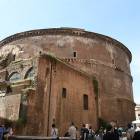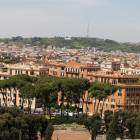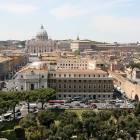Castle Sant Angelo, the fortress of the Popes
This is the best preserved Roman building in Italy’s capital, used almost without interruption since 123 AD, when emperor Hadrian commissioned it as a personal tomb. Very short after, the beautiful bridge over Tiber was built. It connects the mausoleum with the center of Rome, and also offers an easy access from the city to the main square of the Vatican.
The entire history of Rome in entangled with this building’s past. For almost three centuries, it remained what it was meant to be, a tomb for royal heads and their family. The architecture of the original mausoleum was slightly different. It maintained the round aspect with stone and apparent brick, but what is now a terrace for a panoramic view over Roman and the Vatican used to be a garden. On a central tower, where today is the statue of Michael, stood a sculpted quadriga. That is a common artistic element during pagan times, with various solar deities being presented as riding a chariot with four horses. Whether it was the Roman Apollo, the Greek Helios or the Egyptian Ra, the triumphant gallop always symbolized the victorious sun.
After the decay of Rome, about a thousand years of turbulent times followed, during which the solid construction of the former mausoleum as well as its strategic placement were noticed as an asset. With hundreds of years before European knights started building castles to defend their wealth, Catel Sant Angelo was turned into a fortress. It was such used by whoever disputed the city, from Goths to Byzantines and Avars. During sieges the damages, although canons were not yet available, damages were immense, and it is even recorded that the Byzantines used fragments of statues as projectiles against attackers.
A more sinister usage of Catel Sant Angelo was as a prison and execution place. Deposed popes and personalities like Giordano Bruno felt the chilling darkness of the thin marble corridors and cells of this bastion. It is also worth mentioning that not far from here is also the tomb of Saint Peter, martyred in Rome.
The popes also used it as fortress, when fighting for supremacy over parts of the city. But also the pope helped embellish the building and the nearby bridge with statues and decorations of angels, from which the name derives. The most important of these statues is that of Archangel Michael, pulling a sword. Michael is a military angel, that leads the armies of God and according to tradition he will lead the armies against those of the Antichrist at the final battle of Armageddon. The current statue is a remake by Peter von Verschaffelt. Today the castle is a museum of Medieval and Ancient art, offering also a privileged view over Tiber, to the Vatican’s basilica and to parts of Rome.
Mai multe despre: Architecture, Italia • Archangel Michael • Castel Sant Angelo • castle • fortress • Italy • Mausoleum of Hadrian • Middle Ages • Rome • San Pietro • sculpture • Tiber • Vatican- Home Page
start page - Architecture
landmark buildings - Sacred architecture
places of worship - Nature
landscape photography - Concert
performing artists - Christmas
Santa Claus pictures
- Jooble
jobs for photographers - Escape
an out of control blog - Merry Christmas
The best organizer of Christmas parties - Astro photo
Eclipse hunting and astrological photography
















